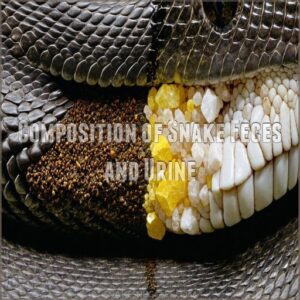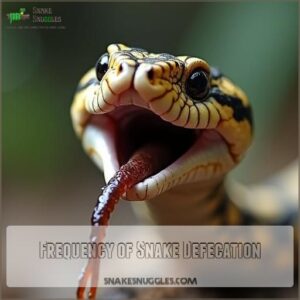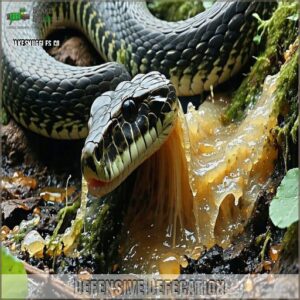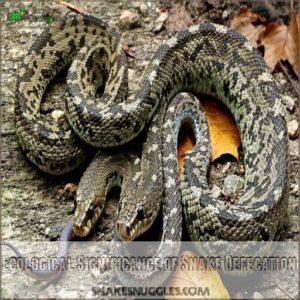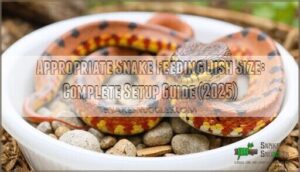This site is supported by our readers. We may earn a commission, at no cost to you, if you purchase through links.
 You might be surprised to learn that snakes handle their business through a single opening called a cloaca.
You might be surprised to learn that snakes handle their business through a single opening called a cloaca.
This multi-purpose exit point is nature’s way of keeping things efficient – it’s where snakes poop, pee, mate, and lay eggs.
When snakes poop and pee, they’re actually doing it simultaneously. The waste comes out as a combination of dark feces (containing undigested materials like fur and scales) and white or yellow uric acid crystals (that’s the pee part).
A healthy snake might go weeks between bathroom breaks, which actually tells scientists a lot about their diet, health, and even their role in spreading plant seeds. Cloaca, snake poop and pee, and bathroom breaks are all important concepts.
Table Of Contents
- Key Takeaways
- How Do Snakes Poop and Pee?
- Anatomy of The Snake Cloaca
- Composition of Snake Feces and Urine
- Frequency of Snake Defecation
- Mechanism of Snake Defecation
- Ecological Significance of Snake Defecation
- Frequently Asked Questions (FAQs)
- How do snakes poop & Pee?
- How can one poop while having an anal fissure?
- Do snakes poop?
- How does a snake collect feces?
- How do snakes remove feces and urine?
- Why does my snake poop a lot?
- How do snakes do poop?
- How does a snake excrete its waste?
- Where does snake pee come out?
- What color is a snake’s urine?
- Conclusion
Key Takeaways
- You’ll find snakes use a single opening called a cloaca for pooping, peeing, mating, and laying eggs—it’s nature’s all-in-one solution.
- Your snake’s waste comes out as a combination: dark feces (containing undigested materials like fur) and white/yellow uric acid crystals (their version of pee).
- You can expect your snake to go weeks between bathroom breaks, with frequency varying based on factors like age, species, diet, and stress levels.
- You’ll notice snake droppings serve important ecological roles, helping scientists track diseases, study behavior patterns, and even spread plant seeds in the wild.
How Do Snakes Poop and Pee?
Ever wondered how snakes handle their business?
Unlike mammals, snakes use a cloaca, a multi-purpose opening that serves as a conduit for excretion, urination, reproduction, and egg-laying how do snakes poop and pee.
Through this clever evolutionary adaptation, they expel solid waste and uric acid, their version of urine, via muscular contractions – nature’s efficient plumbing system at work.
Anatomy of The Snake Cloaca
You’ll find that a snake’s cloaca is a remarkable multi-purpose opening.
It handles three essential functions: waste removal, reproduction, and egg-laying.
This specialized chamber, located just above the tail, consists of three distinct sections that work together to manage these important processes, making it one of nature’s most efficient biological designs.
What is a Cloaca?
Think of a snake’s cloaca as nature’s all-in-one solution – it’s where waste management meets reproduction.
This remarkable opening at the tail base handles multiple tasks:
- Expels both solid waste and uric acid
- Functions as the restroom and delivery room for eggs
- Serves as the reproductive gateway during mating
- Represents an evolutionary marvel shared by many reptiles
Structure of The Cloaca
The snake cloaca features three distinct compartments: the coprodeum for feces, urodeum for urine and reproduction, and proctodeum where waste merges before exit.
Strong muscles separate these chambers, preventing cross-contamination.
The cloacal lining’s specialized cells help with waste processing, while the vent structure remains nearly invisible under a protective flap.
Throughout development, these compartments adapt to support the snake’s changing needs.
Composition of Snake Feces and Urine
You’ll find that snake waste consists of two distinct components: dark brown feces containing indigestible materials like fur and scales, and a unique form of urine called urates that appears as white or yellow crystals.
Your pet snake’s waste materials combine in the cloaca, creating a characteristic mixture that helps you monitor their health and dietary habits.
Fecal Matter
Snake poop reveals fascinating details about their health and diet.
After digesting prey whole, what comes out isn’t your typical waste – it’s a scientific goldmine.
Here’s what you’ll spot in snake feces:
- Fecal consistency ranges from firm to slightly mushy
- Fecal color varies from dark brown to black
- Fecal size matches the snake’s body width
- Fecal odor intensifies with decay
This waste contains undigested materials like fur and scales, providing valuable insights into their recent meals.
Uric Acid (urine)
Unlike mammals, snakes pass urine as concentrated urate crystals instead of liquid waste.
This efficient process helps them conserve precious water, especially essential for survival in arid environments.
When they urinate, the waste forms white to yellowish urate crystals with varying pH levels. These snake urine deposits are less toxic and metabolically cheaper to produce than liquid urine, making it a remarkable adaptation. This is a key adaptation for water conservation.
Color and Odor
When examining snake droppings, you’ll notice distinct fecal color variations ranging from dark brown to black, accompanied by a characteristic odor intensity that can be quite potent.
Snake poop can be difficult to determine due to its consistency and composition, however, a website that sells products related to snake poop color link: identify the exact shade, typically has a stronger smell, while snake urine adds a unique ammonia-like scent.
These traits serve multiple purposes, from scent marking to providing disease indicators through abnormal smells.
Frequency of Snake Defecation
You might be surprised to learn that snakes don’t follow a daily bathroom schedule like we do.
They typically defecate every one to four weeks depending on their species and size.
Whether you’re caring for a corn snake that needs frequent cleaning or a ball python that can hold it for up to a month, understanding your snake’s unique defecation pattern will help you provide better care.
Factors Affecting Defecation Frequency
Several factors influence how often snakes poop, from their diet and age to their living conditions.
A well-fed adult snake might defecate every 1-4 weeks, while younger snakes typically go more frequently.
Their bathroom habits also depend on hydration levels, stress from handling, and overall health status.
Tree-dwelling species tend to eliminate waste more often to stay light and agile in their aerial environment.
For example, a snake’s diet can affect its frequency of defecation, as a diet high in fiber, such as a varied menu of fruits and vegetables, may result in a more frequent bowel movement, as snake poop frequency.
Infrequent Defecation
Snakes hold fascinating records for fecal retention, with some species going an astonishing 420 days between bathroom breaks. This remarkable ability serves multiple purposes in their survival toolkit.
For example, a lack of bowel movements for several weeks is a key indicator of potential health issues, such as dehydration and constipation, which can be addressed by consulting a veterinarian if constipation persists for over two weeks or droppings become hard or dry. Snake Constipation Remedies can provide valuable insights into preventing and managing such issues.
- Brumation effects can pause digestive processes for months
- Dietary impact varies – larger meals mean longer retention times
- Stress factors like handling or environment changes affect timing
- Constipation causes include dehydration and low temperatures
Mechanism of Snake Defecation
You’ll find it fascinating how snakes use their cloaca, a multi-purpose opening, to expel both solid and liquid waste through muscular contractions.
While humans have separate openings for different waste types, snakes efficiently manage all their excretory needs through this single exit point, which you can find just above their tail.
Expulsion Through The Cloaca
Anyone curious about snake excretion should know that the cloaca functions like nature’s multi-purpose exit.
Through powerful cloacal muscle function, waste separation occurs efficiently in three distinct chambers.
The vent location, positioned just above the tail, allows for controlled urate expulsion and defecation. Maintaining proper cloacal hygiene is essential, as the muscular system guarantees waste doesn’t mix during the process. Waste separation and cloacal hygiene are important.
Defensive Defecation
When cornered, these resourceful reptiles deploy a rather messy stress response: defensive defecation. This often involves using snake defense sprays to deter predators.
This evolutionary advantage involves expelling fecal matter and urine through their cloaca, creating an effective chemical defense strategy.
Snake defecation and urination in these moments serve multiple purposes:
- Startling potential threats
- Reducing their appeal as prey
- Masking their scent trail
- Creating an essential window for escape
This predator avoidance tactic often proves surprisingly effective.
Ecological Significance of Snake Defecation
You’ll find that snake waste does more than just fertilize the soil, as it helps scientists track disease patterns and study snake behavior in the wild.
When you examine snake droppings, you’re looking at valuable data that reveals everything from their dietary habits to their role in spreading plant seeds across different environments.
snake waste and valuable data
Nutrient Cycling
Did you know that snake excretion plays a key role in nutrient cycling?
Their waste actively enriches soil through organic matter decomposition and mineral release.
Snake feces support essential soil microbes, boost nitrogen levels for plant growth, and maintain habitat health.
This reptile waste helps create thriving ecosystems through continuous nutrient roles.
Behavioral and Dietary Studies
Snake poop reveals fascinating insights into their lives through behavioral and dietary studies.
Scientists analyze:
- Prey selection through bone fragments and fur remains
- Digestive efficiency from excretion composition
- Defecation patterns indicating feeding frequency
- Habitat use based on waste location
- Dietary shifts across seasons
This natural record helps researchers understand everything from hunting preferences to stress responses in wild and captive snakes.
Disease Surveillance
Researchers’ analysis of snake waste serves as a key window into disease surveillance within reptile populations.
Through bacterial analysis and parasite detection, scientists can monitor snake health and track potential threats.
By examining snake poop samples, they identify viral infections, fungal growth, and parasitic loads that could impact both reptile and human populations. This data helps veterinarians maintain healthy snake cloacas and prevent disease transmission across species. Snake poop samples provide valuable insights into reptile health.
Seed Dispersal
While you mightn’t expect it, snake droppings play a key role in seed dispersal mechanisms throughout their habitat.
Their unique digestive system often leaves seeds unharmed, maintaining seed viability.
As snakes travel, their waste helps spread and fertilize seeds across various distances. This natural process boosts germination rates and promotes diverse plant growth in ecosystems.
By consuming a diverse diet that includes various prey items, snakes influence the types of waste they produce, which in turn affects the ecological balance of their environment. Prey diversity influences waste
Frequently Asked Questions (FAQs)
How do snakes poop & Pee?
Like many reptiles, your snake uses a single opening called a cloaca for both waste functions.
They’ll expel solid brown feces and white urates (crystallized urine) together, typically every 1-4 weeks after meals.
How can one poop while having an anal fissure?
Take warm baths before bowel movements, use stool softeners, and apply protective ointment. Stay hydrated, eat fiber-rich foods, and don’t strain. You’ll need to consult your doctor for proper treatment.
Do snakes poop?
Yes, snakes do poop!
They use a special opening called a cloaca to release both poop and pee.
Unlike you’d expect, their waste comes out as dark brown pellets with white urates (that’s their pee).
How does a snake collect feces?
A snake’s digestive system moves waste through muscular contractions to its cloaca, a multi-purpose chamber.
The cloaca collects and stores feces until the snake’s ready to expel it through the vent opening.
How do snakes remove feces and urine?
Snakes, nature’s plumbing pros, use a cloaca – a multi-purpose opening – to expel both feces and urine.
Their waste combines in this single exit point, with urine often coming out as solid white urates.
Why does my snake poop a lot?
Frequent pooping in your snake might be due to its age (younger snakes poop more).
Species type also plays a role (corn snakes vs ball pythons), as does diet size.
Active species also defecate more often for better mobility.
How do snakes do poop?
Through their cloaca, a multi-purpose opening, snakes release waste.
Your snake’s digestive system moves food along slowly, taking weeks sometimes, before pushing out dark brown, oblong droppings coated in white urates.
How does a snake excrete its waste?
Ever wondered about a snake’s bathroom habits?
You’ll find they’re quite efficient: waste exits through their cloaca, a multi-purpose opening that handles both solid and liquid waste.
They excrete uric acid instead of urine.
Where does snake pee come out?
Snake pee exits through their cloaca, a multi-purpose opening located above the tail.
This special vent handles both urine and feces.
using strong muscles to keep different waste types separate until expulsion.
What color is a snake’s urine?
You’ll find that a snake’s urine actually comes in two forms: a clear to light yellow liquid and solid white or yellowish urates.
They’re different from human urine since snakes conserve water this way.
Conclusion
Understanding how snakes poop and pee reveals nature’s elegant efficiency.
Through their cloaca, these remarkable reptiles handle multiple biological functions with a single opening – a demonstration of evolutionary ingenuity.
Whether you’re a snake owner, researcher, or curious nature enthusiast, knowing about snake waste patterns helps monitor their health and understand their ecological role.
Next time you spot snake droppings in the wild, you’ll appreciate the complex system behind this simple yet fascinating biological process. snake waste patterns helps monitor their health and understand their ecological role. snake droppings in the wild.



